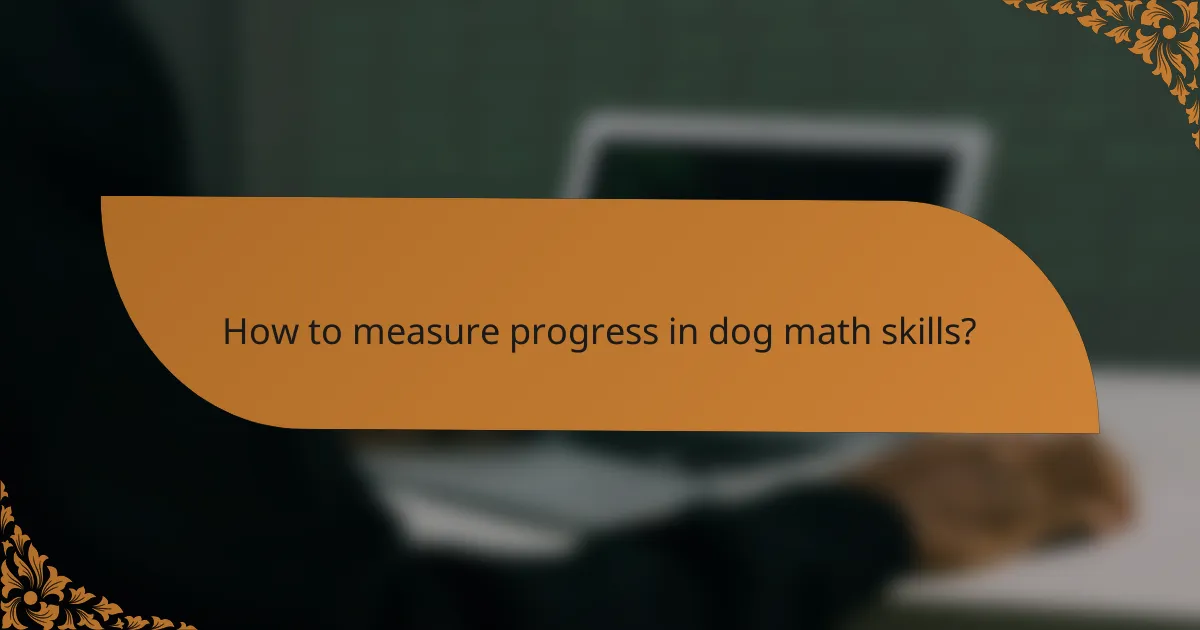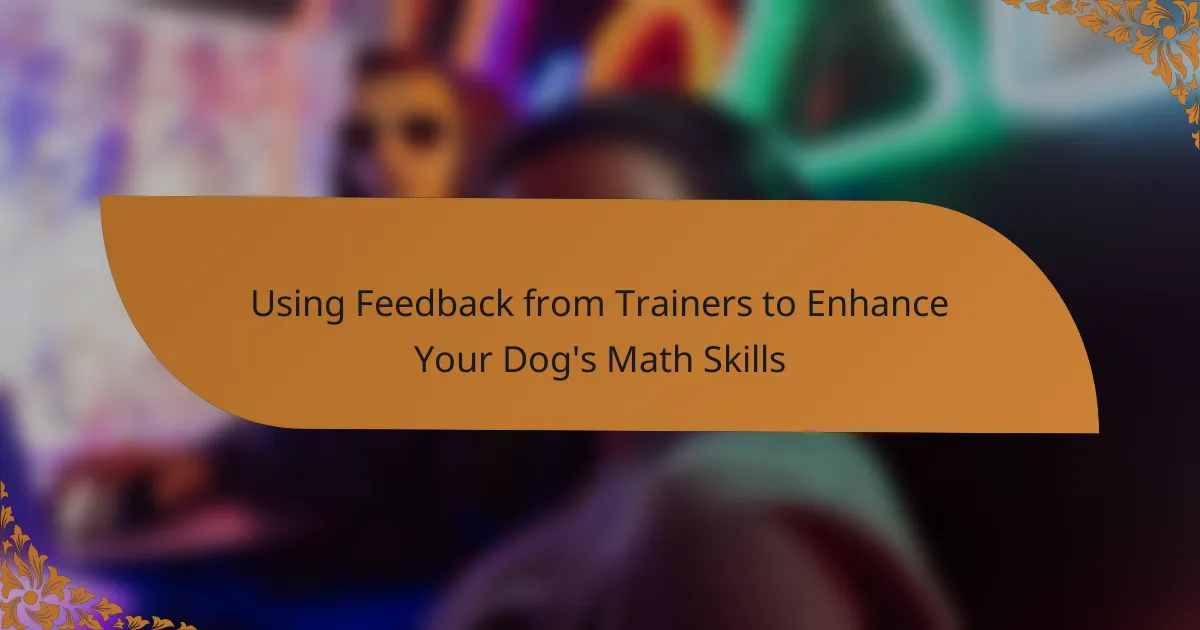Enhancing your dog’s math skills can be an engaging and rewarding experience, especially when trainers utilize effective feedback and innovative techniques. By incorporating positive reinforcement, interactive games, and tailored feedback, trainers can help dogs recognize patterns and solve simple problems, making learning both fun and effective.

How can trainers enhance dog math skills in urban environments?
Trainers can enhance dog math skills in urban environments by utilizing engaging methods that cater to the unique challenges of city living. Techniques such as positive reinforcement, interactive games, and group training sessions can effectively teach dogs to recognize patterns and solve simple problems.
Positive reinforcement techniques
Positive reinforcement techniques involve rewarding dogs for correct responses to math-related tasks, which encourages them to engage and learn. For example, trainers can use treats or praise when a dog successfully identifies the number of objects in a group or performs a simple calculation.
It’s essential to keep rewards immediate and consistent to reinforce learning effectively. Trainers should also vary the types of rewards to maintain the dog’s interest, using toys or playtime as alternatives to treats.
Interactive math games
Interactive math games can make learning fun and engaging for dogs. Simple activities like hiding treats under cups and asking the dog to identify the correct one can help them develop counting skills and problem-solving abilities.
Trainers can also create obstacle courses that require dogs to perform tasks based on numerical commands, such as jumping over a certain number of hurdles. These games not only teach math skills but also promote physical activity and mental stimulation.
Group training sessions
Group training sessions provide a social environment where dogs can learn math skills alongside their peers. This setting encourages healthy competition and collaboration, making learning more enjoyable and effective.
During these sessions, trainers can introduce group challenges that require dogs to work together to solve problems, such as counting how many dogs are present or completing tasks in a specific order. This approach fosters teamwork and reinforces math concepts in a dynamic way.

What specific feedback should trainers provide?
Trainers should provide feedback that is clear, actionable, and tailored to enhance a dog’s math skills. This includes immediate corrections for mistakes and encouragement to boost motivation and confidence.
Immediate corrections
Immediate corrections help dogs understand their mistakes in real-time, reinforcing learning. Trainers should point out errors right after they occur, using a calm and clear tone to avoid confusion.
For example, if a dog miscalculates during a training exercise, a trainer can gently redirect them by saying “No, try again!” This prompt allows the dog to reassess their approach and correct their behavior on the spot.
Encouragement and motivation
Encouragement is essential for maintaining a dog’s interest in math exercises. Positive reinforcement, such as treats or praise, can significantly enhance a dog’s motivation to learn and engage with challenging tasks.
Trainers should celebrate small victories, like correctly solving a simple math problem, to build the dog’s confidence. A simple “Good job!” or a small treat can make a big difference in their willingness to participate.

What tools can trainers use to teach math skills?
Trainers can utilize various tools to effectively teach math skills to dogs, enhancing their cognitive abilities through engaging methods. These tools include clicker training devices and math-focused dog toys, each designed to facilitate learning through positive reinforcement and interactive play.
Clicker training devices
Clicker training devices are popular tools that use a distinct sound to mark desired behaviors, making them effective for teaching math-related tasks. When a dog performs a correct action, such as identifying the number of treats or responding to a command involving counting, the trainer clicks the device and rewards the dog with a treat.
To implement clicker training for math skills, start with simple commands and gradually increase complexity. For instance, you can teach your dog to associate the click with the number of treats they receive, reinforcing their understanding of quantity. Consistency is key, so ensure you click and reward immediately after the desired behavior.
Math-focused dog toys
Math-focused dog toys are designed to engage dogs in problem-solving activities that incorporate basic math concepts. These toys often feature compartments or mechanisms that require dogs to figure out how to access treats based on quantity or sequence, promoting cognitive development.
When selecting math-focused toys, look for those that challenge your dog without causing frustration. Toys that require the dog to push, pull, or manipulate objects to reveal treats can be particularly effective. Regularly rotate the toys to maintain your dog’s interest and keep the learning experience fresh.

How to measure progress in dog math skills?
Measuring progress in dog math skills involves tracking performance over time through various methods. Regular evaluations and behavioral observations can help identify improvements or areas needing attention.
Regular assessments
Regular assessments are essential for gauging your dog’s math skills. These can include timed exercises where your dog solves simple problems, such as counting treats or identifying shapes. Aim for assessments every few weeks to monitor progress and adjust training methods as needed.
Consider using a scoring system to quantify performance. For example, you might rate your dog’s accuracy on a scale from 1 to 10 based on how many problems they solve correctly within a set time frame. This can help you visualize their improvement over time.
Behavior tracking apps
Behavior tracking apps can streamline the process of measuring your dog’s math skills. These apps allow you to log training sessions, track progress, and analyze patterns in your dog’s learning. Look for apps that offer customizable features to suit your specific training goals.
Some popular features to consider include the ability to set reminders for training sessions, record performance metrics, and share progress with trainers or friends. Using these tools can enhance accountability and provide insights into your dog’s learning journey.

What are common challenges in teaching math to dogs?
Teaching math to dogs presents unique challenges, including their natural instincts and varying levels of engagement. Understanding these obstacles can help trainers develop effective strategies to enhance learning.
Lack of interest
A common challenge in teaching math to dogs is their lack of interest in the subject matter. Dogs are often more motivated by physical activities or rewards like treats rather than abstract concepts. To combat this, trainers should incorporate play and positive reinforcement to make learning more engaging.
Using games that involve counting or simple problem-solving can capture a dog’s attention. For example, hiding treats in a specific number of containers can encourage dogs to “solve” the puzzle while enjoying the reward.
Distractions in urban settings
Urban environments can present numerous distractions that hinder a dog’s ability to focus on math training. Noises, other animals, and people can divert their attention away from learning tasks. Trainers should choose quieter locations for training sessions to minimize interruptions.
Additionally, gradually introducing distractions during training can help dogs learn to concentrate despite their surroundings. Start with minimal distractions and slowly increase them as the dog becomes more comfortable with the math concepts being taught.

What are the prerequisites for effective training?
Effective training for dogs requires a foundation of basic obedience and an understanding of individual learning styles. These prerequisites ensure that the training process is smooth and that the dog can grasp new concepts, including math skills, more easily.
Basic obedience training
Basic obedience training is essential for establishing a communication channel between you and your dog. Commands such as sit, stay, and come create a framework that helps your dog understand expectations. Without this foundation, more complex tasks, like math-related activities, may be confusing for the dog.
Start with simple commands and gradually increase complexity. Use positive reinforcement techniques, such as treats or praise, to encourage desired behaviors. Consistency in commands and rewards is key; practice regularly to reinforce learning.
Understanding canine learning styles
Every dog has a unique learning style that influences how they absorb information. Some dogs may respond better to visual cues, while others might learn more effectively through auditory signals or hands-on interaction. Identifying your dog’s preferred learning style can significantly enhance training outcomes.
To determine your dog’s learning style, observe their reactions to different training methods. For instance, if your dog quickly picks up commands through hand signals, they may be a visual learner. Tailor your training approach accordingly, using a mix of techniques to keep the sessions engaging and effective.
